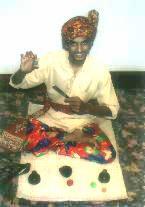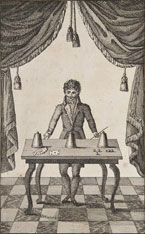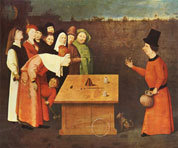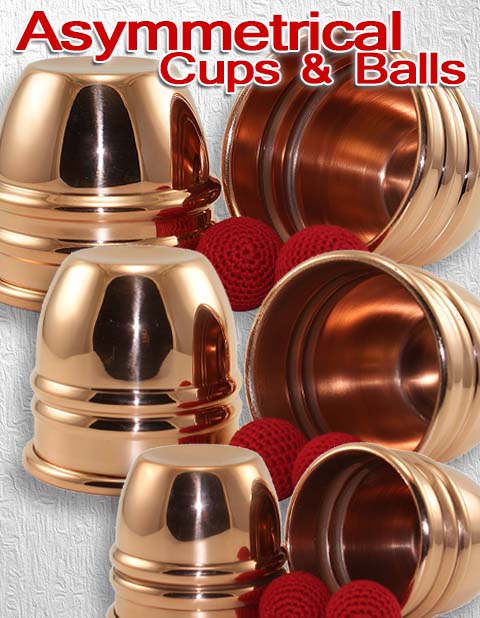-
All categories
-
HIGHEST RATED
-
LOAD BALLS
-
All categories
-
HIGHEST RATED
-
LOAD BALLS
-
All categories
-
HIGHEST RATED
-
LOAD BALLS
-
All categories
-
HIGHEST RATED
-
LOAD BALLS
-
All categories
-
HIGHEST RATED
-
LOAD BALLS
-
All categories
-
HIGHEST RATED
-
LOAD BALLS
At Rings-N-Things we take Cups and Balls Magic Tricks seriously.
by Donnie Buckley
What is the Cups and Balls Magic Trick?
The Cups and Balls is a magician’s trick. Classically it utilizes three cups and three balls. The balls are placed under the cups and magically the balls move between the cups, penetrate the cups, they may multiply or completely vanish, and may even change colors. Traditionally, the cups will subsequently be shown to contain very large objects, like jumbo balls, fruit, or small livestock. Occasionally, a cup might be shown to contain a large quantity of small objects, like coins, pebbles, or salt. And in some cases, the cups will finally be shown to be solid blocks and to not really be cups at all. Some performers cause the cups themselves to appear by magic, others cause the cups to vanish or multiply by magic.
How old is Cups and Balls History?
No one knows the full history of cups and balls for certain. What is known is that the widely popularized ancient Egyptian hieroglyph from the tomb of Beni Hasan, Egypt, of two people sitting with cups is NOT a drawing of the Cups and Balls. When viewed within the context of the surrounding glyphs, the image is depicting some culinary procedure, most likely they are baking bread, but in a recent conversation with Gary Kosnitzky, an authority on Indian Cups and Balls, he stated that he believed the hieroglyph is a depiction of people making and stacking dung bricks which is still done in India today. The dung bricks are burned as fuel for cooking and the hieroglyph would have been appropriately placed in with other culinary procedures.
While ancient Egypt certainly had magicians, as is known from the tales of Dedi (or Djedi) in the Westcar Papyrus from 2000 BC, there is thus far no documented evidence that the ancient Egyptian conjurers did anything resembling The Cups and Balls.
Indian magicians performing the Hindu (or Indian) Cups and Balls, called Cheppum Panthum, may have originated the trick in the Indus Valley as long ago as 5000 years, with coconut shells. The influence of the Indian magicians, from the East, should not be overlooked. It is extremely likely that Western and Roman travelers witnessed the trick and created their own variation of it as it is highly unlikely that Indian magicians would have taught their techniques to outsiders. To this day, magic secrets are handed down from fathers to their sons. The secrets of their trade are kept within the family. It is said that there are 64 moves in Cheppum Panthum and the number of magicians alive in India that know them all can be counted on one hand, perhaps on one finger.
In Western Europe, it is not unreasonable to assume that the Cups and Balls were performed as early as the Bronze Age. The Beaker culture originated around 2800 BC when the so-called Beaker People began to create vessels from pottery. Alcoholic beverages that were drunk from these vessels increased their popularity all across Europe. Archeologists have uncovered these beakers at Stonehenge that are dated 2000 BC, meaning that the beakers traveled all across Europe and arrived at events like festivals at Stonehenge and festivals at Woodhenge. Due to the festival nature of these events, it is likely that the beakers could have been used to entertain people even if most surviving examples are quite large.
Roman conjurers performed acetabula et calculi. The cups were the acetabula, or paropsides. Acetabulum being Latin for a “vinegar cup”. Calculi being the “balls”. An experience of witnessing a conjurer is described in the fictional letters of the Greek Alciphron (between 170 and 350 CE). Alciphron’s great quote, stated by a simple countryman who came to town and saw an exhibition of cup and balls is:
"Letter XX. Napæus to Criniadas. You know that I had laden my ass with dried figs. Having carried them to the place, where I sold them to a man very well known, some one or other carried me to the theatre, where, placing me in a convenient situation, he greatly delighted me with different spectacles. Of the other things I have no perfect recollection, for I confess myself rather dull, either in comprehending or relating such matters. But one thing, when I saw it, rendered me almost speechless, and made me gape with surprise: a certain person advanced into the middle, and, producing a three-footed table, placed upon it three little dishes; under these he concealed some small, white, round pebbles, such as we find on the banks of rapid streams; these he sometimes hid, one by one, under a different dish; and sometimes, by I know not what method, showed them altogether beneath one; at other times he caused them to disappear from under the dishes, and discovered them in his mouth; having swallowed them, he brought those who stood nearest him into the middle, and then pulled one stone from his nose, another from his ear, and a third from his head; finally, he caused them to vanish from the sight of every one. He is a most dextrous fellow; and even beyond Eurybates of Œchalia, of whom we have heard so much. I should be sorry to have such a creature in the country, for we should never be able to catch him in his tricks; and he would steal every thing I had, and strip my farm of all it contains. "
15th century European woodcuts depict an array of street performers with Cups and Balls and Cones on their tables. Many of these images are shrouded in lunar mysticism and occult imagery. 17th and 18th century European woodcuts depict the Cups and Balls performer in taverns and on the street in town centers, surrounded by pedestrians. Some of these images include a gibecière or pouch worn by the performer. Often, they are depicted wielding a wand and appear quite charismatic. 19th century European paintings depict the Cups and Balls performer on a stage.
The earliest known written instructions on how to perform the Cups and Balls were published in 1634 and named Hocus Pocus Junior, The Anatomy of Legerdemain. It is known to have had at least 3 printings thru 1638 and is still available today as a transliterated PDF download, complete with illustrations, thanks to the efforts of Bill Palmer, Curator of The Cups and Balls Museum.
Why are there three cups in the Cups and Balls?
As a game of chance, all three cups are placed mouth down, a ball is placed under one of the cups and all three cups are moved around so fast that which cup contains the ball is unknown. The chances are 1 in 3 that a player could “Find the Ball” under one of the three cups. That’s 2:1 odds against and 1:2 odds in favor of selecting the winning cup – yet the operator may only pay even money to winners.
It would be a fairer game if it was played with only two cups – the odds are 1:1, but you can’t easily mix just two cups.
If the operator used 4 cups, the odds of winning would drop to 1 in 4 (1:3 odds in favor), which should pay more to winners, but might be deemed less desirable for the player and the operator – it’s a tougher game to play.
It is debatable whether or not the Cups and Balls was originally the game of chance: “Find the Ball”.
The famous Bosch painting, The Conjurer, 1475-1505 not only depicts a performance of the Cups and Balls, it also depicts the financial risk one would take if they got too close. Whether or not Bosch’s imagery was a contemporary depiction of a conjuror, or a composite of past and present assumptions about the conjurer’s motives at the end of the 15th century, as well as a satire of the gullible populace, is uncertain. The spectator is intensely fascinated by and focused on the conjurer; there’s a needy child, perhaps acting as an accomplice, prodding the spectator; there’s an owl in the gibecière; there’s a toad in the spectator’s mouth (and another on the table) – all while his pocket is being picked. You can draw your own conclusions, but it helps to interpret the painting if you are familiar with a Flemish proverb that Bosch would have known: "He who lets himself be fooled by conjuring tricks loses his money and becomes the laughingstock of children."
It does seem logical that what is a trick today, originated as a game. Equally logical is the assumption that the game evolved into a demonstration of sleight-of-hand as the observers would eventually realize that the game could not be won because the operator of the game was using some skill to cheat; and ordinary observation would not be enough to find the ball – rendering the game a folly in popular culture. If it was originally a game of chance, it stopped being a game that people would play a very long time ago. In Alciphron’s time he tells the story of a “countryman’s” experience seeing a performance of a "most dexterous fellow" in the "theater" and expresses the fear that "such a creature" would "steal" his property. That doesn’t sound like the depiction of a game of chance. But, as Bosch depicts 600 years later, getting too close to the Cups and Balls is still assumed to be a financial risk.
The Three Shell Game is a game of chance still played on the street today. It is a small, portable, usually disposable version of “Find the Ball”. The Three Shell Game became popular during the end of the 18th century and was played with thimbles or walnut shells, on trains and riverboats – wherever people were en masse and transient. Today it is played with bottle caps – wherever people are en masse and transient. Magic historians debate whether the Three Shell Game or the Cups and Balls came first – which is the chicken and which is the egg? But, if the Cups and Balls began as a game of chance millennia ago, and was played with very small cups, then there is no differentiation to be made. The principles used by the operator of the Three Shell Game differ from those used by the Cups and Balls magician, but that may be more related to the obsolescence of sleights or gimmicks required for the Cups and Balls being handled as a game of chance. It could be that there were deceptive methods of handling the balls as in the Three Shell Game that have been lost to time.
Theatrically, three cups are traditionally used. A performance of the Cups and Balls of the last two centuries is almost always depicted with three cups. The writer's formula of the "Rule of Three" dictates that sets of threes in storytelling are preferable and more satisfying to an audience. It's interesting to consider that the Cups and Balls is actually older than the Latin phrase "omne trium perfectum" (everything that comes in threes is perfect, or every set of three is complete). A longer set of material can be performed with three cups but, theatrically speaking, a performer should be careful not to be repetitious or confusing.
My own theories on the delight we experience from triplets is more based upon our biology and environment. On Earth, we experience Night and Day, and the basic duality of our world is engrained into our very psyche. We have two arms, two legs, two ears and two eyes. We are comfortable with pairs. When a third variable is introduced, an element of uncertainty arises in our sub-conscious, we are outside our primal comfort zone. Consider this example: "The television is on. The television is off." These two statements make a definitive declaration about the state of the television, we understand this without thinking. But when a third variable is declared, as in "The television is on stand-by.", it instills a doubt about the definitiveness of either of the first two. It adds just enough to render what we thought we knew about the state of the television as uncertain. I postulate that when we have duality in writing, theater or comedy, it's simple for us to comprehend, but when just one more element is introduced, our minds begin to wonder, and to even speculate, about other possibilities. Our minds are then engaged and entertained. This can be very beneficial for magicians, as the magician, at times, WANTS their audience to be preoccupied with their own train of thought.
Two Cup Routines
Two cup routines are equally considered Cups and Balls tricks. Two cup routines allow less for confusion to occur and play faster and more direct. Holland’s Tommy Wonder and Canada’s Gary Ouellet independently created wonderful two cup routines.
One Cup Routines
One cup routines primarily consist of Chop Cup routines, but Ball and Cone and pure One Cup routines are age old magic tricks that require the same ball manipulation skills used in a traditional three cup routine.
Why are there Final Loads in the Cups and Balls?
Because audiences may not remember all the tricks the little balls do, but they never forget the final loads, there is a theory that the whole trick is about the final loads, and that the manipulation of the little balls is only included in the trick to cover the sleight-of-hand required to get the loads into the cups. At the same time, there are performers who entertain their audiences with the Cups and Balls and do not produce any final loads. True enough, the magic with the little balls can be astounding and can stand alone, but for the “wow factor”, nothing compares to large final loads appearing under the cups. It is interesting to hear audiences explain away the action with the little balls as being accomplished by “sleight-of-hand” and at the same time declare that they have “no idea where those big balls came from”.
Final loads are a production. It’s the magician creating something from nothing. When well executed, final loads are a finale to a cups and balls routine that declares the end of the performance and queues the audience for an ovation.
When should the Cups and Balls be performed?
Is it an opener? Is it a closer? Is it a showcase segment of your show? Is it an audience participation segment of your show? Is it just filler to extend the length of your show?
The answer to all these questions is: Yes. A Cups and Balls routine can fit in just about anywhere you want to put it in a magic show.
Who performs the Cups and Balls?
Stage, street and close-up magicians all perform the Cups and Balls for large and small audiences. It’s been said that the Cups and Balls contains ALL the plots of a magic show and that no one can call themselves a “magician” unless they can do the trick. It is performed by gifted amateurs, professionals and every kid that got a magic kit with three little plastic cups in it.
How do I learn the Cups and Balls?
There are a vast number of written routines for the Cups and Balls. All one really needs in order to learn the Cups and Balls is the desire to do so, and the commitment to researching published routines, practicing them, and rehearsing them. Learning from books has two distinct advantages. The first being that you can leave a book open to an illustration or paragraph that is describing a move while you are practicing it. The second is that you will naturally develop your own handling of a move as you understood it from a written description or illustration, and the way YOU do it may be different from the way the author did it. It may be better!
There are a vast number of routines taught in video and available on DVD. Learning the Cups and Balls from DVD or video instruction is a quick start method that can aid the student in understanding what a move is supposed to look like, when it might sound confusing in print. While many magicians declare that they prefer to learn from books, many will still look at the video to see how the teacher is executing the moves. Additionally, video instructions can demonstrate the proper timing required. For this reason, even videos that contain poor instructions can be of great value if the trick is performed in real time by the teacher. The single greatest disadvantage of learning from video instructions is that the student will not use their own imagination, or their own invention, to accomplish the moves. They will instead “copy” the technique of the teacher, and in some cases, they will even copy the script the teacher uses. This disadvantage is acceptable for the student, as they can learn a routine, word for word, move for move from the teacher, but any student of the Cups and Balls must come to a point where they need to “be themselves” if they are going to progress as a performer. And they must come to a point where they are inventing their own moves and routines if they are going to progress the Cups and Balls trick.
See also: Cups and Balls Anatomy
© 2012 - Rings-N-Things Magic, all rights reserved.
Comments
-
5 stars2
-
4 stars0
-
3 stars0
-
2 stars0
-
1 star0
Bill
Bestsellers
My account
Customer Service
RINGS-N-THINGS MAGIC
About Us
Subscribe to our Newsletter
Subscribe to our newsletter and get announcements first.
My account
Customer Service
Resources
RINGS-N-THINGS MAGIC
Subscribe to our Newsletter
Subscribe to our newsletter and get announcements first.
© 2009 - 2026 Rings-N-Things Magic. All rights reserved.






